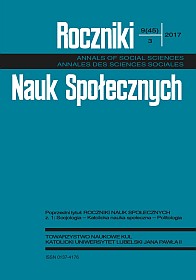Transparency of the Polish Government Structure in the Network Perspective
Abstract
The aim of the paper is to analyze the constitutional crisis, which occurred in Poland at the end of 2015, shortly after the parliamentary election. Our research is focused on showing the low transparency of the Polish government during this political turmoil. We argue that there are many indirect connections and feedbacks between the main political actors which have an effect in the non-transparent structure of a government, which changes during political turmoil and more stable period of time. In this context the network analysis was used as a main research method to emphasize some of the personal connections between the main politicians.
References
Atteveldt W. van, Semantic network analysis: techniques for extracting, representing and querying media content, Charleston, SC: BookSurge 2008.
Benedikter R. & Karolewski I., Poland‘s conservative turn of 2015: Where are its real origins?, in: Europe in Trouble, ed. H. Marhold, Nomos 2016, pp. 81-88.
Berelson B., Content analysis in communication research, New York: Hafner Press 1984.
Brin S. & Page L., The Anatomy of a Large-scale Hypertextual Web Search Engine, in: Proceedings of the Seventh International Conference on World Wide Web 7, Amsterdam, The Netherlands: Elsevier Science Publishers B. V. 1998, pp. 107-117.
Domański H., A New Dimension of Social Stratification in Poland? Class Membership and Electoral Voting in 1991-2001, “European Sociological Review” 24(2)/2008, pp. 169-182.
Freeman L.C., Centrality in social networks conceptual clarification, “Social Networks” 1(3)/1978, pp. 215-239.
Granovetter M., The Strength of Weak Ties, “American Journal of Sociology” 78(6)/1973, pp. 360-1380.
Garlicki L.L., The Experience of the Polish Constitutional Court, in: Constitutional Justice, East and West. Democratic Legitimacy and Constitutional Courts in Post-Communist Europe in a Comparative Perspective, ed. W. Sadurski, The Hague–London–New York: Kluwer Law International 2007, pp. 265-282.
Krippendorff K., Content analysis: an introduction to its methodology, 2nd ed, Thousand Oak: SAGE Publications 2004.
Lin N., Social capital: a theory of social structure and action, Cambridge, UK–New York: Cambridge University Press 2001.
Lin N., A network theory of social capital, in: The handbook of social capital, ed. D. Castiglione, J.W. van Deth, & G. Wolleb, New York: Oxford University Press 2008, pp. 50-70.
Marcinkiewicz K., Stegmaier M., The parliamentary election in Poland – October 2015, “Electoral Studies” 41/2016, pp. 221-224.
Markoff J., Shapiro G. & Weitman S.R., Toward the Integration of Content Analysis and General Methodology, “Sociological Methodology” 6/1975, pp. 1-58.
Markowski R., The Polish parliamentary election of 2015: a free and fair election that results in unfair political consequences, West European Politics 39(6)/2016, pp. 1311-1322.
Nooy W. de, Mrvar A. & Batagelj V., Exploratory social network analysis with Pajek, New York: Cambridge University Press 2005.
Opinion on Amendments to the Act of 25 June 2015 on the Constitutional Tribunal of Poland, Adopted by the Venice Commission on 11 March 2016, http://www.venice.coe.int/webforms/documents/default.aspx?pdffile=CDL-AD(2016)001-e, [20.05.2017].
Pennebaker J.W., Francis M.E. & Booth R.J., Linguistic Inquiry and Word Count. Mahwah, N.J.: LEA Software and Alternative Media, Inc., 2001.
PKW (State Electoral Commission), www.parlament2015.pkw.gov.pl, [15.05.2017].
Stanley B., Confrontation by default and confrontation by design: strategic and institutional responses to Poland’s populist coalition government, “Democratization” 23(2)/2015, pp. 263-282.
Stępińska A., Lipiński A., Hess A. & Piontek D., Poland: A Fourth Wave of Populism?, in: Populist Political Communication in Europe, ed. T. Aalberg [et all], London: Routledge 2017, pp. 311-325.
Szczerbiak A., Poles Together? The Emergence and Development of Political Parties in Postcommunist Poland, Budapest: Central European University Press 2001.
Szuleka M., Wolny M., Szwed M. (2016), The Constitutional Crisis in Poland 2015-2016, http://www.hfhr.pl/wp-content/uploads/2016/09/HFHR_The-constitutional-crisis-in-Poland-2015-2016.pdf, [18.05.2017].
The Constitutional Tribunal Act of 22 July 2015, http://www.venice.coe.int/webforms/documents/default.aspx?pdffile=CDL-REF(2016)052-e, [23.05.2017].
Tamkin E., Polish Ruling Party Passed Unconstitutional Law, Now Controls Constitutional Tribunal, “Foreign Policy”, 2016, http://foreignpolicy.com/2016/12/19/polish-ruling-party-passed-unconstitutional-laws-now-controls-constitutional-tribunal-trump-law-justice/, [18.05.2017].
Urban J., Bulkow K., Tracing Public Opinion Online – An Example of Use for Social Network Analysis in Communication Research, “Procedia-Social and Behavioral Sciences” 100/2013, pp. 108-126.
Wałęsa L., The State of Democracy in Poland and Europe, “Polish Political Science Yearbook” 45/2016, pp. 157-165.
This paper is a part of the research project no. 2015/19/B/HS5/00426 financed by Polish National Science Centre.
Copyright (c) 2017 Roczniki Nauk Społecznych

This work is licensed under a Creative Commons Attribution-NonCommercial-NoDerivatives 4.0 International License.


